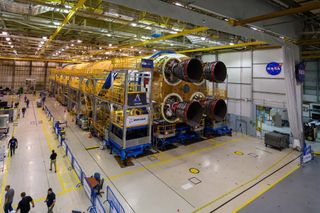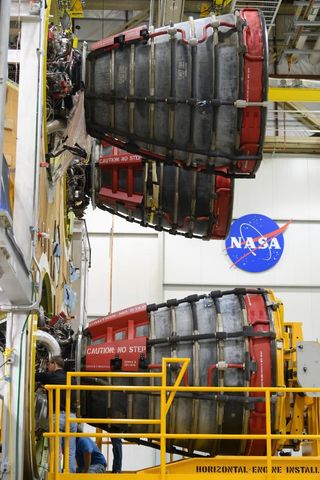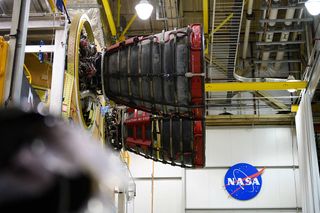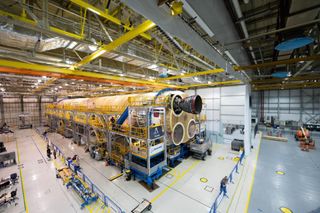NASA's first new megarocket bound for the moon now has all of its engines for the first uncrewed lunar flight of the U.S. space agency's Artemis program.
NASA officials captured the milestone in a new photo, which shows four RS-25 engines attached to the core stage (the first stage) of the agency's massive Space Launch System rocket, which is tasked with bringing astronauts to the moon's surface in 2024.
This first SLS will launch an uncrewed Orion spacecraft around the moon in a mission dubbed Artemis 1. Orion will release some cubesats to study the moon before flying back to Earth for a high-speed test reentry. That mission is scheduled for 2020, but could slip to 2021 depending on how testing goes.
Video: Watch NASA's SLS Megarocket Get Ready for New US Moon Missions

All four RS-25 rocket engines are seen attached to the first core stage of NASA's Space Launch System megarocket in the Michoud Assembly Facility in New Orleans, Louisiana.
(Image credit: NASA)

All four RS-25 rocket engines are seen attached to the first core stage of NASA's Space Launch System megarocket in the Michoud Assembly Facility in New Orleans, Louisiana.
(Image credit: NASA)

All four RS-25 rocket engines are seen attached to the first core stage of NASA's Space Launch System megarocket in the Michoud Assembly Facility in New Orleans, Louisiana.
(Image credit: NASA)

The third RS-25 rocket engine is seen attached to the core stage of NASA's first Space Launch System rocket.
(Image credit: NASA)

The third RS-25 rocket engine is seen attached to the core stage of NASA's first Space Launch System rocket.
(Image credit: NASA/Eric Bordelon)

The first core stage of NASA's Space Launch System rocket is seen with it's second RS-25 rocket engine.
(Image credit: NASA/Eric Bordelon)

NASA's first Space Launch System rocket core stage received its first RS-25 rocket engine in late October 2019.
(Image credit: NASA/Jude Guidry)
"The completed core stage with all four RS-25 engines attached is the largest rocket stage NASA has built since the Saturn V stages for the Apollo program that first sent Americans to the moon," NASA officials said in a statement, referring to the program that oversaw human moon-landing missions between 1969 and 1972.
Technicians are now integrating other systems into the rocket, including the propulsion and electrical systems. Once the rocket is all put together, NASA and its partners will test the flight computers, electrical systems and avionics in the core stage to get ready for the big launch day. "This testing is the first time all the flight avionics systems will be tested together to ensure the systems communicate with each other, and will perform properly to control the rocket's flight," NASA added.
The RS-25 engine type was used on the space shuttle program that flew between 1981 and 2011. While the shuttle was designed for low-Earth orbit missions, the SLS is much larger (385 feet, or 117 meters tall) and is intended to bring astronauts to the moon and Mars.
Integration of the core stage is being performed by NASA, Boeing (the core stage lead contractor) and Aerojet Rocketdyne (the RS-25 engines lead contractor).
Follow Elizabeth Howell on Twitter @howellspace. Follow us on Twitter @Spacedotcom and on Facebook.
Bagikan Berita Ini














0 Response to "NASA's 1st SLS Megarocket Core Stage for the Moon Has Its Engines (Photos) - Space.com"
Post a Comment